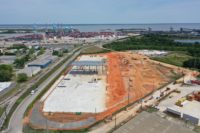Many factors come into play when considering a low-voltage contractor to install network infrastructure at cold storage facilities. Here are some tips when preparing to vet or work with a managed services provider, or a low-voltage contractor, that can ensure better infrastructure for your company.
1. Understand the Technology Needs of the Cold Storage Facility
Before searching the web for a contractor, take the time to plan for the technology required for the facility to operate. Here are a few things to consider:
- Wireless network access: Are scanners, phones and other wireless devices used throughout the facility?
- Wired network access: Are there stationary devices such as computers or IoT devices that need access to the network? Is there an office space that needs Ethernet cables at each desk?
- Security cameras: Are cameras needed internally and/or externally? Who will need access to view those cameras?
- Access control: How many doorways will need access control?
- Network Rack: Is there power and space centrally located and available for the installation of a network rack? Redundant power is always recommended
- Fiber Demarc Extension and MPOE: Is there a separate room where the internet circuit enters the building? Cabling will need to be installed between the minimum point of entry (MPOE) and main distribution frame (MDF).
It is OK not to have all of the answers right away, as a professional low-voltage contractor should be leading you in the right direction to deliver the most efficient network infrastructure to meet your business needs. It helps to have a list of items that you can show the installer detailing the parts of your network that need focus. This pre-work provides a more accurate estimate for both project cost and installation timeline.
2. Find a Low-Voltage Contractor and Schedule a Site Visit
Start looking early, because low voltage contractors are not typically available on short notice. Once the site visit is scheduled, it is advisable to have the main electrical contractor present as well, to assess the power needs for each network closet/IDF (intermediate distribution frame). Because of the layout of cold food storage facilities, the IDF location may be on the roof of the cold storage room, which usually does not have electricity to power the network equipment within the IDF. These IDFs are usually network rack-mounted for easy accessibility to keep it protected and to maximize the cold storage efficiency and space. Be prepared to have building diagrams in both physical and digital copies to share with your contractor.
Here are a few questions to ask a low-voltage contractor during a site walk-through:
- Will you be drilling through the walls of the refrigerated or frozen area, if so how do you plan to seal those holes?
- How will you be running the cable throughout the facility? How will you ensure the cable is secured?
- How will you ensure the quality and reliability of each cable run?
- Do you have the cable pathways you need to be able to support the network infrastructure?
3. Double Check Cable Paths
A network can come in various topologies and it is important to understand each section of topology when talking to the contractor. The MPOE, the minimum point of entry, is a room within the facility where the Internet Service Provider (ISP) provides their handoff to the internet. This handoff is where the responsibility of network services shifts to the internal IT team of the facility. It is important to keep these MPOE rooms clutter-free, accessible and powered with reliable source.
In cold storage facilities, it may not be as obvious that these areas need to stay cool as well. This will ensure that the ISP equipment has the best chance of staying powered on and that it is easy to service when a problem does arise.
A demarcation extension is needed from the MPOE to reach the MDF (main distribution frame). This is usually done with fiber cable, which is referred to as a fiber demarc extension. There needs to be a cable pathway from the MPOE room to the MDF room. A majority of the time low voltage contractors do not install long conduit runs or ladder racks. Generally, they specialize in the cable run, termination and network connectivity instead. The pathway for fiber demarcation can be in conduit or a ladder rack; what is important is that it is protected.
Make sure the low-voltage contractor installs and terminates a multiple-strand fiber cable, in case the fiber is damaged, there is a secondary strand to use. Because it is the main connectivity point, this cable will be the lifeline of the entire network of the facility, there must be no damage to the cable. It is also optimal to ensure that light levels during testing are perfect. If the budget is available, make sure your low-voltage contractor performs an OTDR (optical time domain reflectometer) test on those fiber lines to ensure reliability.
The MDF is the core of the internal network for the facility, where the brains of the network live. It is important to keep this room secured, cool and clutter-free, to improve network uptime and easy serviceability. Within the MDF there will need to be a space for a network rack that houses the equipment, attached either to the wall or to the ground, depending on the network requirements of the facility. Within the rack, the low voltage contractor will install the usual items depending on the contract like routers, switches, fiber distribution panels, copper patch panels and NVR for security cameras.
Depending on the size of the facility, there will be an IDF (intermediate distribution frame), this a subunit of the MDF. There will be a fiber cable run between the MDF and IDF, similar to the cabling between the MPOE and MDF. Be sure that a low-voltage contractor is running a multiple-strand fiber cable to best support network connectivity for redundancy. IDFs are needed throughout large facilities because of the recommended length when running copper cabling.
The best practice for installing cat5/6 cable is not to exceed a distance of 100 meters. This can vary, depending on the layout and complexity of the facility. To have network infrastructure properly reach all areas of the facility, it is important to strategically place the IDF so the contractor is not running cables to connect network devices such as wireless access points and cameras more than that 100-meter distance specification.
Unfortunately, this is an easy way for contractors to cut corners and while you may not see network degradation immediately, it has the potential to cause problems in the future. Take the time to understand the dimensions of your facility, the expected throughput, and the minimum network specifications - this will help you work with the contractor to find the best location for the IDF.
4. Pay Attention to Wireless Network Design
The foundation of excellent Wi-Fi is good planning and design. If you are working with an MSP and/or low-voltage contractor, take some time to have them explain to you what their plans are. The last thing you want is for workers to have poor wireless connection throughout the facility, slowing down the operational process. Initial planning and hardware decisions can have a dramatic positive impact on day-to-day network accessibility.
High ceilings and storage racks, typical in a warehouse setting, make for a significantly different wireless coverage design compared to an office space. For an office space, the type of antennas used are omnidirectional, which covers a wide area; these work great in open spaces with shorter ceilings. However, for a cold storage facility, the ideal wireless setup is directional antennas sending the wireless signal down each storage aisle from both sides. This design will require more wireless access points but will increase network efficiency. Do not underestimate the wireless attenuation concerns caused by the storage racks filled with product; attenuation in the real world will change with the stored products weakening the wireless signal. That problem can be avoided by using directional wireless access points.
The mounting positions of wireless access points are important as well, make sure that they are not in the way of getting hit by any potential forklifts, AGVs, etc. Because the access points will be inside the cold storage area, be sure to reiterate that the contractor must seal up any holes made while getting the cable through walls.
This is where having a diagram of the facility is very important; by having the contractor place their wireless access points on a map and, if possible, having them perform a heat map. A heat map will ensure proper testing of the network wireless signal.
5. Crossing the Finish Line and the Post-Installation Process
During a recent installation project on a 72,000-square-foot cold storage facility, the scope of work included setting up over 40 security cameras with an NVR, deploying 30 access points, extending a fiber demarcation and configuring two racks to house all core network equipment. To accomplish this, over 20,000 feet of cable was run in a week. It is typical for low voltage contractors to take up to four weeks to complete installations, depending on the amount of workers allocated to the job site.
The ease of the network installation is directly correlated to the planning, the more effort put into the planning, the better the installation phase will go.
The contractor should provide an operational handoff of the installation summarizing everything installed. Ask for updates from the contractor and get them to label all cable runs on both ends of the cable, in the patch panels and on the device side. This documentation will be key when servicing the facility in the future. Not all network installation professionals will be servicing the infrastructure after the installation, so cold storage operators need to be able to know what was done and how it works together. This is particularly important over the years, as your internal employee turnover might complicate internal hand-offs between technology partners and new staff members.
Conclusion
Hopefully, these suggestions can help you feel more confident as you choose a partner in new construction or expansion of your cold storage facility. It is always best to get a full picture of what a third-party service contractor will be doing, expecting, and needing to complete a project to your satisfaction. It might be advantageous to work with a non-local partner in some instances - like when you need a higher level of technical expertise, or have specific project needs that a certain provider can accommodate. On particularly large or complex projects, you might want to get a second opinion on plans or run concepts by more than one low-voltage contractor as well. This helps find inadequacies before mistakes or oversights affect the project.






